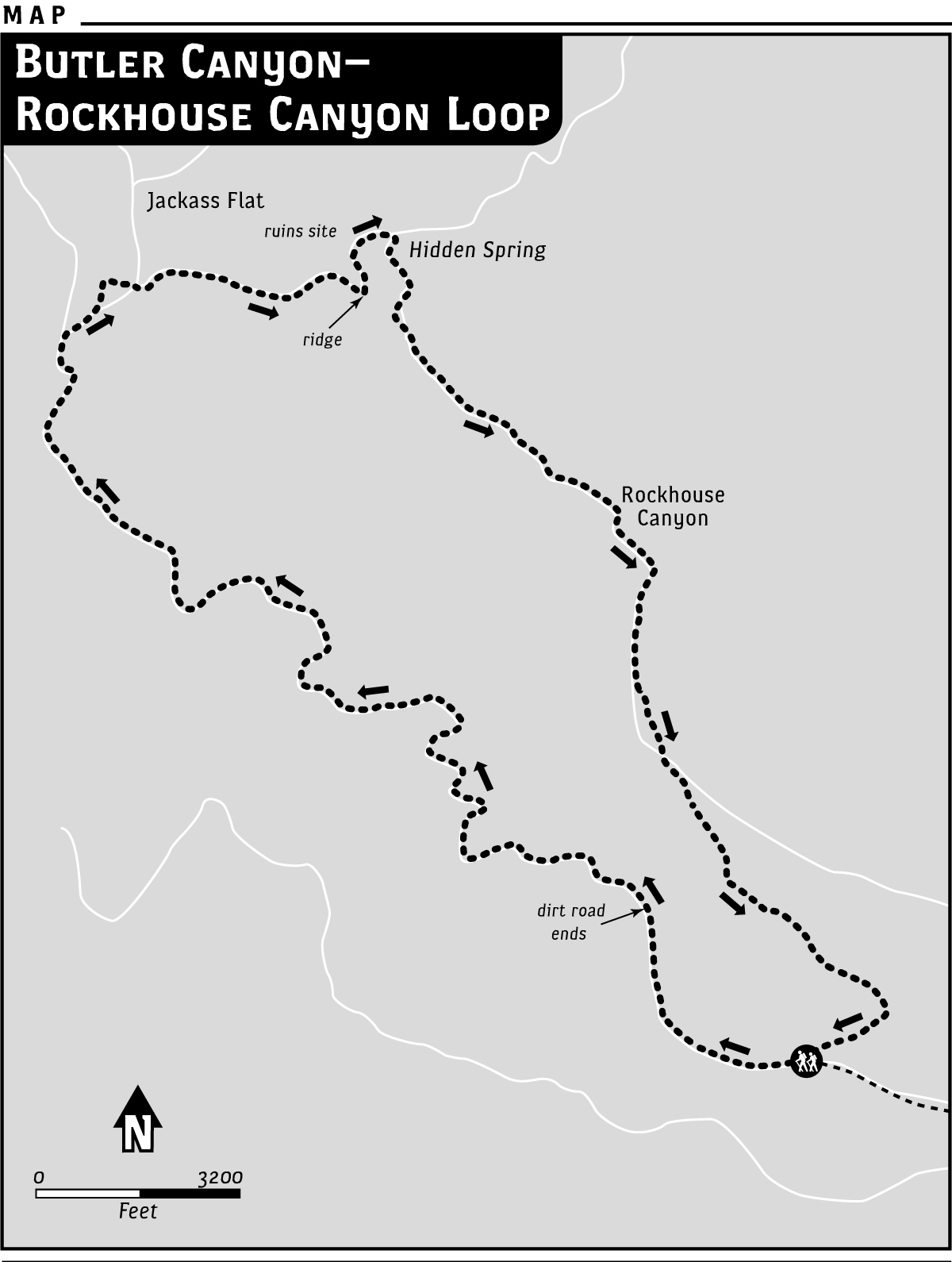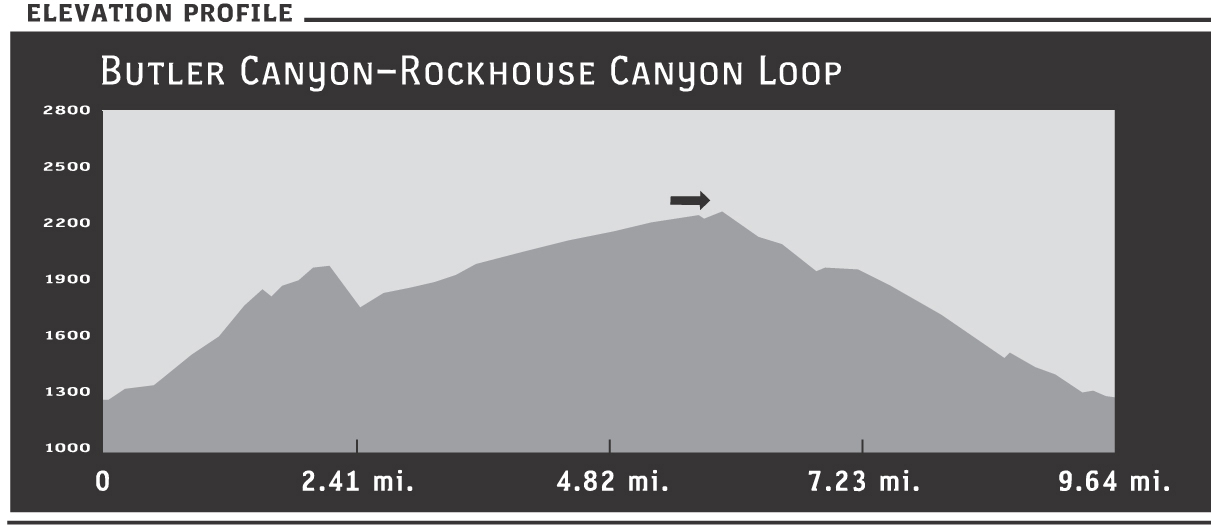13 Butler Canyon–Rockhouse Canyon Loop
SCENERY: 
DIFFICULTY: 
TRAIL CONDITION: 
SOLITUDE: 
CHILDREN: 
DISTANCE: 9.6 miles round trip
HIKING TIME: 6–6.5 hours
OUTSTANDING FEATURES: Canyon views, interesting rock formations, open desert/desert wash, and a hidden spring
A wonderful day hike with fairly easy terrain, this long loop leads through the twisting upper end of Butler Canyon and across open desert before approaching a precipice overlooking Rockhouse Canyon. You’ll pass near a Cahuilla Indian ruin site, so you could spend extra time exploring there, then take the narrow path down into Rockhouse Canyon and loop back to your car.
OPTION: The wide-open space between upper Butler Canyon and Rockhouse Canyon makes for an interesting overnight experience. At night, the star-studded sky seems to go on forever. An easy backpack into this loop’s midpoint leaves an equally easy finish for the following day—after rising with the sun and perhaps cooking over a campfire (in a metal container, of course, as park rules dictate).
Directions: From Borrego Springs, drive east on Palm Canyon Drive. Continue almost 6 miles before the road veers left, becoming Pegleg Road. Drive on Pegleg for 8 miles to Rockhouse Canyon Trail and turn right. The pavement ends after several hundred yards, but continue on the dirt road (four-wheel drive recommended but not always necessary for high-clearance vehicles). After 1.3 miles, you will come to a split in the road. Bear left and continue, passing Clark Dry Lake on your right. After 3.2 miles on the dirt road, pass a sand company gate and continue following the dirt road, bending right. At 8.8 miles from the Pegleg Road turnoff, you’ll come to a trail marker pole where Butler and Rockhouse canyons meet. Park just off the road.
| GPS Coordinates | 13 BUTLER CANYON–ROCKHOUSE CANYON LOOP | |
| UTM Zone (WGS84) | 11S | |
| Easting | 558973 | |
| Northing | 3694390 | |
| Latitude–Longitude | N 33º 23’ 13.8346” | |
| W 116º 21’ 57.3140” |


 You could take the loop from either direction, but I prefer Butler Canyon—the left-hand leg—at the outset. At just under 1 mile, the dirt road ends. Continue northwest into the center of the narrowing canyon, climbing over some boulder stands but staying on a relatively identifiable and continuous footpath. Marvel at the canyon walls, varnished a deep desert bronze (the effect of microscopic bacteria). Butler Canyon is reminiscent of old Hollywood westerns, the terrain perfect for ridgetop lookouts and surprise ambushes.
You could take the loop from either direction, but I prefer Butler Canyon—the left-hand leg—at the outset. At just under 1 mile, the dirt road ends. Continue northwest into the center of the narrowing canyon, climbing over some boulder stands but staying on a relatively identifiable and continuous footpath. Marvel at the canyon walls, varnished a deep desert bronze (the effect of microscopic bacteria). Butler Canyon is reminiscent of old Hollywood westerns, the terrain perfect for ridgetop lookouts and surprise ambushes.
After less than 2 miles, you’ll reach a wide wash that continues northwest for another 2 miles. At 4.2 miles, the wash bends to the right (northeast). After another 0.5 miles, the canyon opens. Make sure you turn more to the right now (east) rather than continuing north into Jackass Flat. The flat land between Butler and Rockhouse canyons was named for wild burros that once roamed here, though the burros have been gone since the early 1970s.
Moving east, you’ll begin to see more ocotillo. The incidence of cholla cactus also thickens, but not so much as to be an issue for hikers. After another mile (5.8 miles from the trailhead), you’ll come to the ridge overlooking Rockhouse Canyon, which appears rather suddenly, so be careful not to let children run ahead. If you have time, explore a little before going down the path into the canyon. Above Rockhouse Canyon is a Cahuilla Indian ruins site. You might be able to spot evidence of the natives’ lives here in this protected site, in the form of piled rocks (for their fires or houses), but identification isn’t easy for the untrained eye.
Whether or not you search for ruins, be sure to pause a bit to absorb the view of Rockhouse Canyon. There’s something mesmerizing about this deep gorge etched rather suddenly into the land. Perhaps this is one reason the Indians chose this site. When you’re ready to move on, look for the narrow, worn footpath leading down into the canyon, which first heads north, then bends east. Be careful—this path may be slippery in spots due to loose rocks and soil.
At the bottom, you’ll need to backtrack (left) about 50 feet to see Hidden Spring, which is not much more than a bit of moisture covered in vegetation. The spring lives up to its name. You’d likely miss it entirely if you didn’t know of its presence or perhaps see bees hovering and realize what they’re after.
From the spring, turn back around and head southwest into Rockhouse Canyon. Meander a little in the wide path, enjoying this last leg of the loop back to your car, along the canyon framed by sandstone and conglomerate walls.